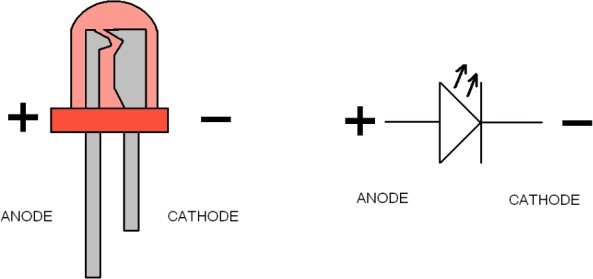LED (Light Emitting Diode)
An LED (Light Emitting Diode) is a semiconductor device that emits light when current flows through it in the forward direction. Unlike traditional incandescent bulbs or fluorescent lamps, which generate light through heating or gas excitation, LEDs produce light through the process of electroluminescence. When electrons pass through the semiconductor material, they recombine with electron holes, releasing energy in the form of photons, which we perceive as light. This makes LEDs highly efficient and durable light sources, with far lower energy consumption compared to conventional lighting technologies.
The structure of an LED typically consists of a p-n junction, where the p-type semiconductor (which has an abundance of positive charge carriers or holes) and the n-type semiconductor (which has an excess of negative charge carriers, or electrons) are joined together. When a voltage is applied, electrons from the n-type material move toward the p-type material, recombining with holes and releasing energy in the form of light. The color of the emitted light depends on the energy band gap of the semiconductor material used, which can be engineered to emit light in the visible spectrum, as well as in the ultraviolet and infrared ranges.
One of the key advantages of LEDs is their energy efficiency. They convert a higher percentage of electrical energy into light, with much less wasted as heat compared to incandescent bulbs, which lose around 90% of their energy as heat. LEDs are available in a wide range of colors, and their brightness can be controlled by adjusting the current supplied to them. White LEDs, commonly used in lighting, are typically made by combining blue or ultraviolet LEDs with phosphor coatings that emit white light when excited by the LED's emission.
LEDs are also known for their long lifespan. Unlike incandescent bulbs, which have filaments that burn out over time, LEDs have no such fragile components and can last tens of thousands of hours, making them more durable and reducing the frequency of replacements. Their compact size, robustness, and low heat generation make LEDs ideal for use in a variety of applications, including displays, indicators, automotive lighting, and general lighting in homes and businesses. Additionally, their small form factor allows them to be integrated into smart lighting systems, where their brightness and color can be controlled remotely.
Despite their many advantages, LEDs can be more expensive upfront than traditional bulbs, but their longer lifespan and lower energy costs make them a more cost-effective solution in the long run. Today, LED technology continues to evolve, with advancements in efficiency, color accuracy, and versatility, making them a central component in the future of sustainable lighting.
The structure of an LED typically consists of a p-n junction, where the p-type semiconductor (which has an abundance of positive charge carriers or holes) and the n-type semiconductor (which has an excess of negative charge carriers, or electrons) are joined together. When a voltage is applied, electrons from the n-type material move toward the p-type material, recombining with holes and releasing energy in the form of light. The color of the emitted light depends on the energy band gap of the semiconductor material used, which can be engineered to emit light in the visible spectrum, as well as in the ultraviolet and infrared ranges.
One of the key advantages of LEDs is their energy efficiency. They convert a higher percentage of electrical energy into light, with much less wasted as heat compared to incandescent bulbs, which lose around 90% of their energy as heat. LEDs are available in a wide range of colors, and their brightness can be controlled by adjusting the current supplied to them. White LEDs, commonly used in lighting, are typically made by combining blue or ultraviolet LEDs with phosphor coatings that emit white light when excited by the LED's emission.
LEDs are also known for their long lifespan. Unlike incandescent bulbs, which have filaments that burn out over time, LEDs have no such fragile components and can last tens of thousands of hours, making them more durable and reducing the frequency of replacements. Their compact size, robustness, and low heat generation make LEDs ideal for use in a variety of applications, including displays, indicators, automotive lighting, and general lighting in homes and businesses. Additionally, their small form factor allows them to be integrated into smart lighting systems, where their brightness and color can be controlled remotely.
Despite their many advantages, LEDs can be more expensive upfront than traditional bulbs, but their longer lifespan and lower energy costs make them a more cost-effective solution in the long run. Today, LED technology continues to evolve, with advancements in efficiency, color accuracy, and versatility, making them a central component in the future of sustainable lighting.
